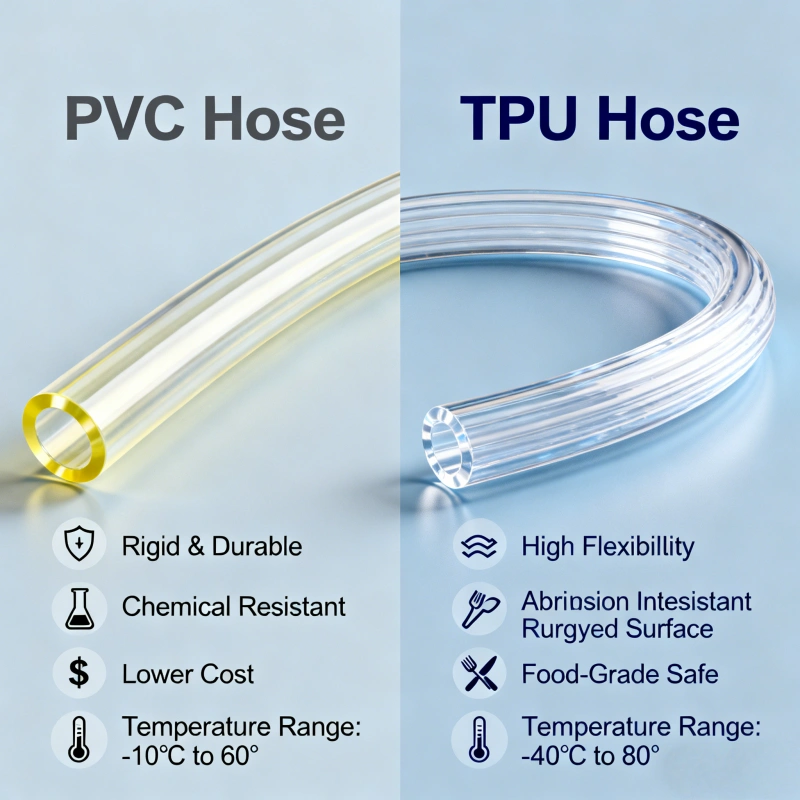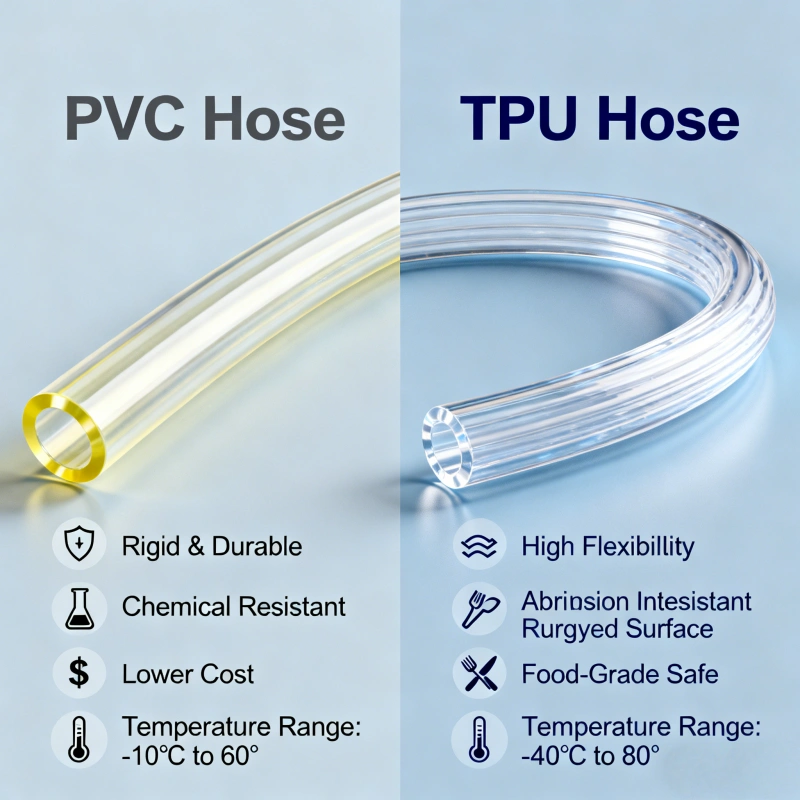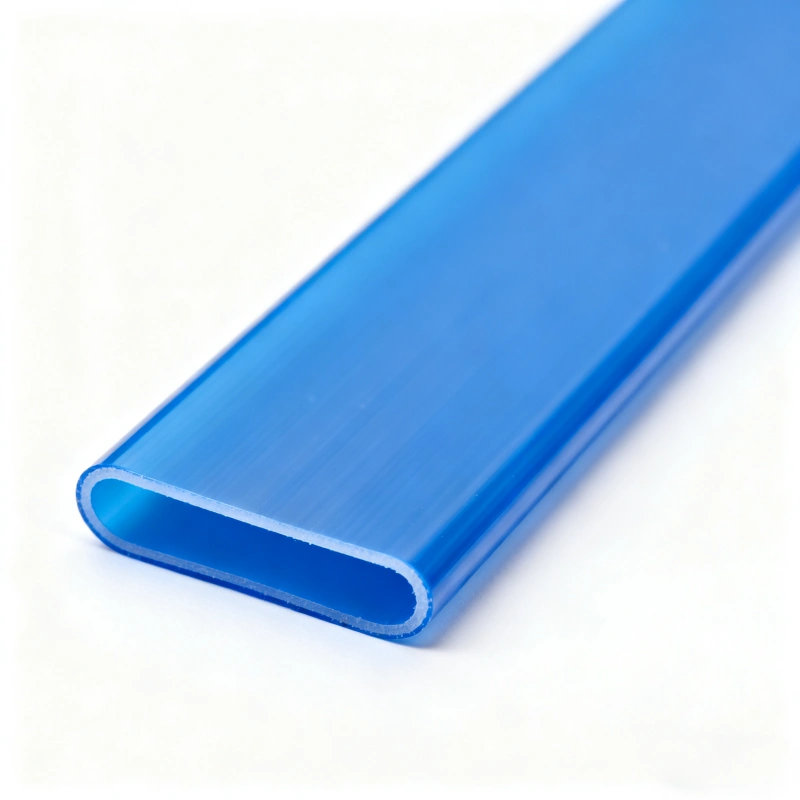PVC vs TPU Hose: Differences, Applications, and How to Choose (2025 Guide)
PVC (Polyvinyl Chloride) hoses and TPU (Thermoplastic Polyurethane) hoses are popular in agriculture, construction, industry, and fluid transfer systems.

They overlap in some uses, but their behavior under real-world stress is not the same. Understanding the differences helps avoid the classic “cheap hose breaks at the worst time” scenario.
What Is a PVC Hose?
PVC hose is made from polyvinyl chloride combined with plasticizers to increase flexibility. It’s widely used because it’s affordable, easy to produce, and comes in countless variations: reinforced PVC, nylon-braided PVC, lay-flat PVC, suction PVC—you name it.
Strengths: Cost-effective, lightweight, chemically resistant
Weaknesses: Stiffens in cold weather, lower abrasion resistance, weaker elasticity
PVC is the everyday worker: not fancy, but reliable as long as you keep conditions reasonable.
What Is a TPU Hose?
TPU (Thermoplastic Polyurethane) is a high-performance elastomer known for toughness, elasticity, and resistance to abrasion, oils, and weathering. TPU hoses often outperform PVC in demanding conditions such as mining, fuel transfer, robotics, and harsh outdoor environments.
Strengths: Excellent abrasion resistance, high flexibility, long lifespan
Weaknesses: Higher price, sometimes overkill for light-duty use
TPU behaves like a professional athlete—fast, strong, and highly adaptable.

Material and Performance Differences
1. Flexibility
PVC: Flexible but stiffens in low temperatures
TPU: Remains flexible in cold and hot conditions
A PVC hose at –10°C can feel like wrestling a frozen python. TPU stays supple.
2. Abrasion Resistance
PVC: Moderate
TPU: Extremely high
TPU is preferred where dragging the hose over concrete, gravel, or metal is unavoidable.
3. Temperature Range
PVC: –10°C to +60°C (varies)
TPU: –40°C to +90°C
TPU survives winter and high-pressure heat like it has no opinion about physics.
4. Chemical Resistance
PVC: Good with acids, alkalis, and some chemicals
TPU: Superior with oils, fuels, and solvents
Fuel handling almost always goes TPU.
5. Pressure Rating
PVC: Lower working pressure
TPU: Higher working pressure and burst strength
If the pump is powerful, TPU plays safer.
6. Weight
PVC: Lighter
TPU: Slightly heavier due to stronger structure
PVC wins the “carry it all day” award.
7. Lifespan
PVC: 1–3 years depending on UV and environment
TPU: 5–10 years in heavy-duty conditions
Over time, TPU often ends up more cost-effective despite the higher price.
Applications: Where Each Hose Performs Best
PVC Hose Applications
• Agriculture irrigation
• Garden watering
• Construction water discharge
• Low-pressure air supply
• Household and general-purpose use
• Light industrial fluid transfer
• Chemical transfer (non-oil-based)
• Lay-flat water pump discharge
PVC excels when budgets matter and the environment isn’t extreme.
TPU Hose Applications
• Mining and tunnel water/dust discharge
• Fuel and oil transfer
• Firefighting
• High-pressure pump systems
• Robotic automation (pneumatics)
• Abrasive material transfer
• Outdoor harsh-environment setups
• Industrial hydraulic support lines
TPU’s durability and elasticity shine in tough conditions.
How to Choose: PVC vs TPU Hose
Choosing wisely is easier when you consider real operating conditions.
Choose PVC When:
• Budget matters
• Usage is occasional
• Pressures are low to medium
• The hose won’t face heavy abrasion
• The environment is mild (no extreme cold or heat)
PVC is the practical solution for farms, daily tools, and medium-duty tasks.
Choose TPU When:
• Abrasion and drag are unavoidable
• You need high pressure and long lifespan
• Fuel, oils, or solvents are involved
• Extreme temperatures are expected
• The cost of hose failure is high (mining, fire, industry)
TPU is the premium, long-term investment.
Price Comparison (Approximate Market Range)
PVC: $0.60–$2.50 per meter
TPU: $4.00–$12.00 per meter
The price gap comes from TPU’s superior physical properties and engineering complexity.
Which One Should You Choose?
If the job is light to moderate, PVC is affordable and sufficient.
If the job is demanding, TPU pays for itself by avoiding failures, leaks, and stoppages.
PVC is like using a solid everyday sedan.
TPU is like using an all-terrain, high-performance machine that doesn't complain no matter where you take it.
Each hose has its place, and the best choice depends on the environment, lifespan expectations, and criticality of performance.
If you want a comparison table or recommendations based on your exact industry, there’s a whole universe of hose engineering quirks left to explore.

